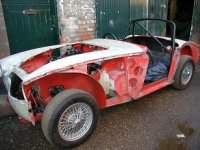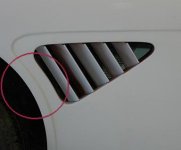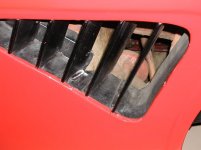Mornin' Steve,
Note that the rise in the back of the pictured hood is IN THE hood, not the cowl.
'Tis, for the most part, true that the cowl is a high pressure area. Moving air generally creates a low pressure area. Still air generally ceates what is called a high pressure area although that "High Pressure" is rarely above atmospheric.
As the air moves up over the hood and makes the transition to move up the windsheild, a relatively still air "zone" is created somewhere in the cowl area.
What we don't know is WHERE that zone starts and where that zone ends. Many factors affect that start line, including the air splitter behind the front bumper. Frontal air dams are often used to lower that split line and move the still zone at the cowl.
Lacking a wind tunnel and smoke wand, discovering air flows can usually only be investigated by taping short lengths yarn (or light string) to the body and driving the car.
On the Healey, the rear edge of the hood is about 16" from the base of the windsheild. What remains to be seen is whether or not the rear edge of the hood is in a moving or still air zone. The PO of that hood was betting that it was in the moving. Pete Farmer is betting that it is in the still.
Right now, probably none of us really know. It'll be interesting to find out.
Here in Dallas, we have a Chev/Healey
with the radiator in the trunk.. Richard and I did a lot of "yarning" of the whole car to discover the airflow patterns in order to optimize the airflow into the trunk for maximum cooling.
There is a whole 'nuther topic for a White Paper.
If I can get hold of a car, I plan to "yarn" the hood/cowl and fender vent areas to find out both.
Tim
PS - Whether people like what Richard has done with his Healey or not, most people would have "crunched" what he started with. He has put one more Healey back on the road.

 Hey there Guest!
Hey there Guest!
 smilie in place of the real @
smilie in place of the real @
 Pretty Please - add it to our Events forum(s) and add to the calendar! >>
Pretty Please - add it to our Events forum(s) and add to the calendar! >> 







 A friendly reminder - be careful what links you click on here. If a link is posted by someone you don't know, or the URL looks fishy, DON'T CLICK. Spammers sometimes post links that lead to sites that can infect your computer, so be mindful what you click.
A friendly reminder - be careful what links you click on here. If a link is posted by someone you don't know, or the URL looks fishy, DON'T CLICK. Spammers sometimes post links that lead to sites that can infect your computer, so be mindful what you click.